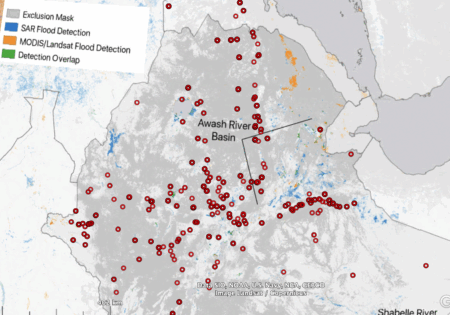- A little more safety for Ukraine’s seeds, thanks to a new genebank.
- A little more safety for Mexico’s native maize, thanks to Pres. Sheinbaum.
- A little more safety for Andean agriculture, thanks to Ecuadorian Indigenous women and Inside Mater in Peru.
- A little more safety for Ischia’s zampognaro bean and Amalfi’s lemons, thanks to local people (and GIAHS).
- A little more safety for Pacific crops, thanks to cryopreservation. Breadfruit next?
- A little more safety for moringa? At least in Africa with all its “opportunity crops”?
Brainfood: Biodiversity intactness, Landuse change, Drought stress, Crop suitability, Yield variance, Phenotypic data
- Consistent global dataset on biodiversity intactness footprint of agricultural production from 2000 to 2020. Spatial dataset shows how global consumption drives ecological degradation.
- Rapid monitoring of global land change. Spatial dataset shows how in 2023 direct human action and fires caused land use conversion globally over an area the size of California.
- Remote monitoring of plant drought stress with the apparent heat capacity. Spatial dataset can provide early warning of drought. Early warning system for genetic erosion, anyone?
- CropSuite v1.0 – a comprehensive open-source crop suitability model considering climate variability for climate impact assessment. Spatial dataset shows where 48 crops will have the best yields.
- Climate change increases the interannual variance of summer crop yields globally through changes in temperature and water supply. Spatial dataset shows that climate change impacts not just yields but variation in yield from year to year for maize, soybean and sorghum.
- Reassessing data management in increasingly complex phenotypic datasets. Datasets need to be properly managed to be widely used.
Nibbles: Ancient Mexican seedbank, Indian millets, Foraged foods, Soybean breeding, Apple breeding, Albanian heirlooms, Bangladesh fish genebank
- People in the Nejapan Sierra Sur in Oaxaca, Mexico had a seed bank 400-700 years ago so they could re-create their complex cuisine after disruptions.
- How MSSRF revived millets in Odisha, India. You think a seed bank was involved?
- Meanwhile, in Meghalaya (also India), foraged foods are helping to diversify state-provided school lunches and address chronic malnutrition. Talk about complex cuisine. Are all these species in a seed bank somewhere, though? Do they need to be?
- How the National Soybean Germplasm Collection at the Agricultural Research Service lab in Urbana, Illinois helped save soybeans in Iowa.
- University breeding programmes are keeping the apple afloat in the USA. That and genebanks.
- Farmers and agrotourism are bringing back some cool flavors in Albania. Well, that and the Albanian Gene Bank.
- Fish need genebanks too, and Bangladesh is on it. Did ancient Bangladeshis have them, I wonder?
How to revive your landraces
How can you get humble heirloom varieties of the humble potato back into cultivation? Well, fortunately, Potato News Today 1 has a handy step-by-step guide, which I reproduce verbatim below:
- Start with a story you can legally sell. In Europe/UK, use the conservation-variety route; in North America, lean on certified seed suppliers and Indigenous stewardship agreements.
- Source clean, traceable stock. CIP and the U.S. Potato Genebank maintain indexed, disease-tested material; combine with reputable local seed houses.
- Pilot with chefs and specialty retail. Early-season launches with menu credit and a farm feature move the needle.
- Package the provenance. PDO/PGI examples like Jersey Royal and Papas Antiguas de Canarias show how origin, agronomy, and micro-harvest rituals create value.
- Engineer storage for shape and use. Follow the curing/holding guidance above.
- Ride the calendar. Tie launches and media to the International Day of Potato (30 May) or to local potato festivals.
Sounds pretty sensible, and applicable to other crops as well, I suspect, with a little tweak here and there.
The article also has a list of case studies. This doesn’t include any examples from Italy, but coincidentally a recent paper describes just such a thing. Which maybe points to something that is missing from the Potato News Today playbook, to whit having lots of interesting characterization and other data on your heirloom landraces handy to help get them ready for prime time.
Before the flood
So, three years back, I posted about the floods in Pakistan, and how genebanks could potentially help farmers recover any crop diversity they lost because of them. But wouldn’t it be even better if the danger of flooding could be predicted? That way crop diversity from at-risk areas could be collected, if not already in genebanks, and multiplied up ready to be distributed should disaster strike.
Well, a recent paper does just that, using AI, no less: “We use our model predictions to identify historically flood-prone areas in Ethiopia and demonstrate real-time disaster response capabilities during the May 2024 floods in Kenya.”
I’ve managed to geo-reference a screen grab of the Ethiopia map provided in the paper using MapWarper, import it into Google Earth, and add the locations of sorghum landraces as reported in Genesys. Here’s what I got.
Unlike in the Pakistan example, there’s not much in the way of genebank accessions from areas of Ethiopia that are particularly at risk from flooding, it seems from this. However, Genesys does not (yet) include geographic provenance data for sorghum from the national genebank of Ethiopia. The 4000-odd sorghum accession from Ethiopia currently in Genesys are conserved at ICRISAT.
